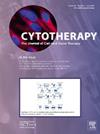Higher risk of GVHD but better long-term survival: impact of p-ALG versus r-ATG in high-risk hematological malignancy patients following MSDT
IF 3.7
3区 医学
Q2 BIOTECHNOLOGY & APPLIED MICROBIOLOGY
引用次数: 0
Abstract
Purpose
Disease relapse and graft-versus-host disease (GVHD) represent significant clinical challenges for high-risk hematological malignancies (HM) patients undergoing HLA-matched sibling donor transplantation (MSDT). How to balance the effect of GVHD and Graft versus leukemia (GVL) remains unclear for high-risk HM patients receiving MSDT. Here, we conducted a retrospective study to compare the efficacy in preventing disease relapse of 2 lymphocyte-depleting antibodies (r-ATG vs p-ALG) as the GVHD prevention strategy.
Method
A retrospective analysis was conducted on 48 patients with high-risk HM patients who underwent MSDT at our center from January 2019 to January 2024. Among them, 22 patients were in the p-ALG group (45mg/kg), and 26 patients were in the r-ATG group (3.5–4.5mg/kg). The primary end point of this study was disease relapse.
Results
We found that the p-ALG group had a higher 3-year cumulative incidence of chronic GVHD than the r-ATG group (64.4% ± 13.6% vs. 28.8% ± 9.7%, P = 0.016). There was no significant difference in total acute GVHD (aGVHD) (54.5% ± 11% vs.26.9% ± 8.9%, P = 0.81) and 3-year extensive cGVHD (20.3% ± 11.3% vs. 7.9% ± 5.5%, P = 0.27) between the 2 groups. In terms of patient prognosis, the p-ALG group showed a higher 3-year overall survival rate compared to the r-ATG group (100% vs. 75.5% ± 8.8%, P = 0.039). The 3-year disease-free survival (DFS) rate was significantly higher in the p-ALG group compared to the r-ATG group (95.5% ± 4.4% versus 61% ± 10.6%, P = 0.046). Furthermore, the p-ALG group exhibited a longer duration of disease remission after transplantation, as evidenced by a lower 3-year cumulative incidence of post-transplantation Minimal Residual Disease positivity (post-MRD+) compared to the r-ATG group (4.5% ± 4.4% versus 40.5% ± 11%, P = 0.022).
Conclusion
In comparison to r-ATG, the administration of low-dose p-ALG (45mg/kg) in high-risk HM patients receiving MSDT is associated with an increased incidence of GVHD but results in a more favorable survival prognosis.
求助全文
约1分钟内获得全文
求助全文
来源期刊

Cytotherapy
医学-生物工程与应用微生物
CiteScore
6.30
自引率
4.40%
发文量
683
审稿时长
49 days
期刊介绍:
The journal brings readers the latest developments in the fast moving field of cellular therapy in man. This includes cell therapy for cancer, immune disorders, inherited diseases, tissue repair and regenerative medicine. The journal covers the science, translational development and treatment with variety of cell types including hematopoietic stem cells, immune cells (dendritic cells, NK, cells, T cells, antigen presenting cells) mesenchymal stromal cells, adipose cells, nerve, muscle, vascular and endothelial cells, and induced pluripotential stem cells. We also welcome manuscripts on subcellular derivatives such as exosomes. A specific focus is on translational research that brings cell therapy to the clinic. Cytotherapy publishes original papers, reviews, position papers editorials, commentaries and letters to the editor. We welcome "Protocols in Cytotherapy" bringing standard operating procedure for production specific cell types for clinical use within the reach of the readership.
 求助内容:
求助内容: 应助结果提醒方式:
应助结果提醒方式:


